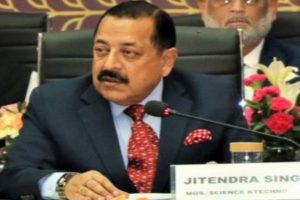Popularly known as ‘the Rain Man of India’, G Asok Kumar, a 1991 batch IAS officer, has devoted half his career to building water harvesting infrastructure in various parts of the country. He probably is the only officer who has conceived and constructed over 48 lakh water conservation and rainwater harvesting structures under the ‘Jal Shakti Abhiyan’ in just six months’ time when he was working for the National Water Mission in remote parts of the country. Presently, he is heading the National Mission for Clean Ganga as the Director-General and has introduced a new concept, ”Earth Ganga”, which is aimed at developing economic activities around the river so as to generate employment.
In an interview with Vijay Thakur, Kumar spoke on how economic activities could be developed around Ganga to make the ”Clean Ganga” mission self-sustainable in the long run.
Q. Work on ”Clean Ganga” has been going on for years. What difference do you propose to make to maintain cleanliness of the river?
A: We have introduced the concept of ‘Earth Ganga’ to create economic activities around Ganga and connect people with the river. During the National Ganga Council Meet in 2019, Prime Minister Narendra Modi had expressed his desire to make Clean Ganga self-sustainable. He strongly believes that people must be engaged with the river and asked us to explore ways and means to connect local people with some economic activities. The government cannot keep pumping money to clean the river… so we have to find ways to make people dependent on the Ganga.
Q. What would be your roadmap to make ‘‘Clean Ganga’’ self-sustainable?
A: The first step is to encourage zero-based natural farming in the river basin area. The use of chemicals not only harms the soil but also contaminates the river. The zero-based farming would not only improve water quality but also increase biodiversity in the area. We are contacting experts and educating farmers. There is one farmer in Anantpur in Andhra Pradesh who has been doing zero-based farming and making it 365-day farming with the minimum use of water. Such inspiring stories would attract people to go for organic farming. It would be a win-win situation for all as it would reduce agriculture expenses, increase quality of food grains, increase production in the long run, save water and improve water quality.
Another project we have is to go for agro-forestry and grow medicinal plants within the 5 km range of the river. We are trying to connect local farmers with companies manufacturing ayurvedic medicines. Indian herbs are much in demand worldwide, particularly after the Covid-19 pandemic and we can avail this opportunity to generate revenues for people living around the river. We are also engaging Farmer Producers Organisations (FPOs) to market medicinal plants and agroforestry products.
Q. But this is only one aspect of it, what about other ways of generating employment using river Ganga?
A: Yes, this is only one aspect of it. We have also approached CIRFI (Central Inland Fisheries Research Institute), Kolkata and asked them to give us Hilsa fish seeds to develop the fresh water fishery industry in river Ganga. Hilsa is a very popular and soughtafter food fish in the Indian subcontinent. It has suitable climate for breeding in river Ganga. Once the river is clean, it would breed in the area. Further, we are also making fish-ladders or fish-bypasses for the movement of Hilsa fish in Ganga barrages for free movement of fish where climate is suitable for breeding.
Freshwater fisheries would bring income to people living on river banks and they would take care of the river as it would generate revenues for them. We are contemplating cold storages at some designated places to ensure a better price for fish. This way we would be able to make Ganga a source of livelihood for the people living around it. The government is employing people as ‘Ganga Prahari’ to conserve the biodiversity of the river. As a result, we are sighting more and more Ganga Dolphins. According to an estimate it had reduced to mere 200. After the ‘Clean Ganga’ Mission, it has increased to more than 600. This a clear indication that water quality has improved in the river.
Q. What about the Sewage Treatment Plants (STPs) in towns around Ganga? What plans do you have to make them self-sustainable?
A: We are making around 160 STPs in 97 towns in and around Ganga. The local municipalities have to spend regularly to run these STPs. Our target is to make it economically viable and learn a few lessons from Suraj (Gujarat) and Tiruppur. While Surat municipality earns more than Rs 140 crore annually by selling treated water to industry at the rate of Rs 45 per 1000 litres, the Tiruppur Municipality’s net profit from the STP is around Rs 40 crore. Both municipalities are now cash-rich and earning more than they spend on running the STP. In fact, it is one of their main sources of revenue. We want to prepare a similar business model for these STPs to make them economically viable.
One, the local bodies can sell the water to industry. Two since the treated water is rich in NPK (Nitrogen Potassium and Phosphorus), it can be used for irrigation purposes as well. This way it would reduce the usage of fertilizer, and conserve our underwater reservoirs. And precious potable water would not be used for non-potable purposes. Another byproduct of the STP is sludge. We are also planning to make the best use of it. We can make biogas from the sludge. A similar project is there in Dinapur in Varanasi, where a 140 MLD (Million Litre Per Day) plant is producing enough electricity to run the plant. Secondly, we propose making bio-manure from the sludge provided it meets the prescribed parameters, or making tiles out of it. It is practically possible, we only have to see how to make it economically viable.
Q. You are also developing Ganga Ghats and beautifying them. Can this also earn revenue for the local authorities?
A: Yes, we are also working on these lines. We are constructing jetties in selected towns and these can be harnessed to promote tourism, trade and commercial activities. The Prime Minister is strongly of the view that we can protect Ganga only if we manage to generate revenue and livelihood for people living around it. Once it becomes a source of livelihood, people would automatically take care of the river. There are many historical and religious places around Ganga. If we manage to promote local tourism in these areas, the local authorities need not spend extra on managing these jetties.
In a nutshell, we are working to channelise the potential of river Ganga to generate revenue for the local authorities, business for local traders and employment for local youth. Once we manage to make a platform on these lines, our mission is complete and all stakeholders will try to keep the river clean.












